
Just about everyone I know is, in some way, striving to become more eco-conscious (yay!). But at times the whole process can seem overwhelming. Don’t let yourself feel too bogged down; even small changes can make big progress. If we can each adjust our habits little by little, over time we can positively impact the planet in a major way without feeling overwhelmed. In case you need a little inspiration this Earth Week, below are seven small habits you could work on. Try adding one to your routine each day and imagine the difference you will have made by Earth Week next year!
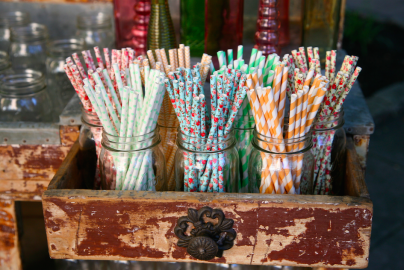
1. Swap to biodegradable paper or stainless steel reusable straws. Do you get drinks on the go? Disposable plastic straws may seem tiny and insignificant, but if you treat yourself to a slurpable drink once a week, that’s 52 straws per year that you’re contributing to landfills. And since plastic doesn’t decompose like paper, though you only used each of those straws one time, they may take up space on our planet for hundreds of years (or more)! Even worse, as they do eventually break down, they can have toxic effects on wildlife and the planet.
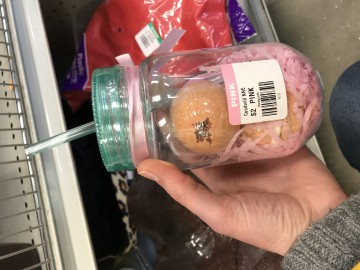
But if those Monday morning iced coffees or Friday afternoon smoothies feel like they’re the only things that get you through the week, don’t break your habit—adjust it! You can have your cake—errr, drink—and enjoy it, too! “Green” your habit by consuming less plastic. Bring a reusable cup and reusable or biodegradable straws. This travel cup and straw set that I found at Goodwill comes with two bath bombs! Not sure what the connection between those two things is, but I can assure you that I’ll enjoy both parts of this $2 buy!
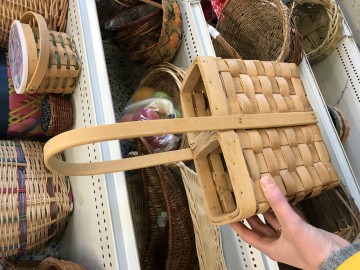
I also saw this darling little sectioned basket while I was thrifting this weekend. If you need a reminder to grab a straw on your way out the door, try popping this on the kitchen counter in plain sight and create a cute display with colorful paper straws or stainless steel ones. If they’re right out in the open, you’re more likely to make it a habit to grab one on your way out the door!

2. Add air-cleaning greenery to your home. Does your weekly routine include watering plants? Certain plants can help to remove toxic chemicals and pollutants from airspace contributing to cleaner indoor air. Once you’re in the habit of caring for spider plants, snake plants, peace lilies, or whichever air-cleaning plant you choose, you’ll be able to breathe a little easier and take your green thumb outdoors!
Since one of the main functions of plants is consuming carbon dioxide and producing oxygen, the more plants you can introduce to your environment (inside or out), the better it is for your health and the health of our planet! Try to get at least two plants per 100 square feet inside your home or office. Instead of buying new plastic planters, scope out the options at Goodwill that have already lived one life. I found this adorable trio of ceramic dinosaurs just waiting to be filled with some soil and succulents. But don’t limit yourself to real planters! What second-hand items catch your eye that can be repurposed to pot plants?
3. Start a compost. Instead of tossing your biodegradable scraps in the trash, look for a compost pail at Goodwill to start making your own healthy soil! If you have yard space, create a compost pile outside to build rich dirt from your waste material. Not only will this decrease the amount of trash you send to the landfills, it will also minimize your output of methane (a greenhouse gas which has increased substantially due to human activity and is contributing to climate change). Even if you live in a city and don’t have space outside, you can still enrich the Earth with the right foundation for new plant growth. Just look into compost pick-up or drop-off options in your area. Many cities have them these days!
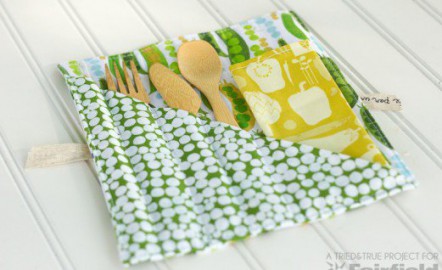
4.Make an Earth-friendly utensil travel set from thrifted fabric and silverware. Get in the habit of carrying it around so you’ll never need to grab plastic silverware when you’re eating on the go! Hey, you could even add your Earth-friendly straw!
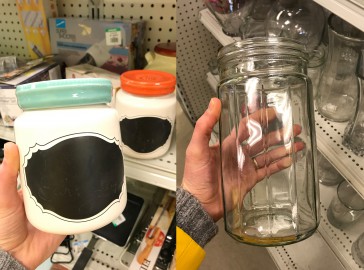
5.Stop buying your regular dish tabs. We’re creatures of habit and once we find a certain product we like, we tend to stick with it. The problem is that products like dish tabs usually come in plastic bags and can sometimes include freaky chemicals. But you still need to wash your dishes, right? So how about making your own dish tabs with more natural ingredients? Crank out large batches of these babies and stash them in a cute countertop jar you find at Goodwill.

6.Don’t reach for the heat when you’re cold! Instead of cranking the thermostat up when you’re cold, throw on an extra layer. Just remember that not all layers are created equal; look for wool socks and sweaters or down vests. These natural fibers are seasonal staples that have been keeping people warm through frigid winters long before we had the heating options we have today. By changing this habit you’ll use fewer fossil fuels and create less pollution. You’ll also save money—win, win!
But wool and down are expensive, right? Not at Goodwill! Especially at this time of the year. Right now people are doing their spring cleaning which means they’re donating a lot of winter layers to make room for summer styles. Snatch those babies up now so you’ll be ready for when the temps drop down again in the fall. I found these snuggly sweaters at my local Goodwill this weekend. They’re from Abercrombie & Fitch and Gap and each one is at least 25% wool—so cozy!

7.Instead of tossing everything in the dryer, hang dry! I still struggle with this one myself. It’s just so much faster and easier to throw freshly-washed laundry into the dryer. But, again, you’re not doing the Earth any favors by relying on a dryer to finish off your laundry routine. In the past, one of the biggest things that has hung me up is having too much laundry for my clothes-horse inside. In the summer, of course, hanging everything outside is a refreshing and free way to get stuff dry, but in the winter I’d rather not live in a draped-laundry forest. So, join me in making my laundry day habits more eco-friendly. Here’s how:
Instead of having a designated laundry day where you wash a week’s worth of clothes, do no more than one load of laundry per day. This will mean that you do it more often, but it won’t take as long and you can hang-dry your clothes without a massive amount of clothing strewn about your space. Prepare one area with the right hanging fixtures and get in the habit of hanging. This could mean thrifting a clothes horse, stringing up a retractable laundry lines inside, or both! Goodwill has plenty of items to help you build the right area to hang-dry in your home.
So, what do you think? Are you up to this Earth Week challenge? Just focus on one habit each day and carry those forward with you through the rest of the year until it becomes your new routine! Even if you’re only changing one of these this year, you’re still making a positive difference. They may be little ways to help the environment, but they’re each beneficial. What are your favorite ways to live an eco-friendly life?
